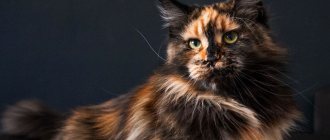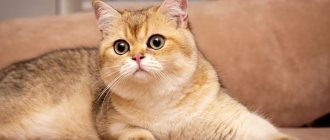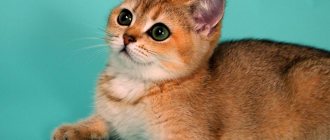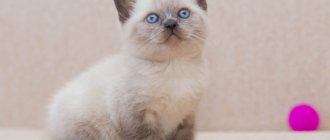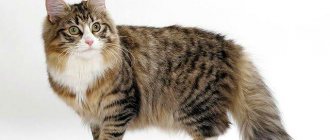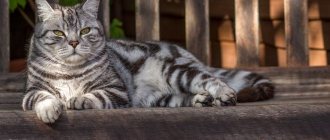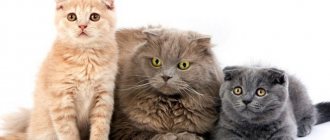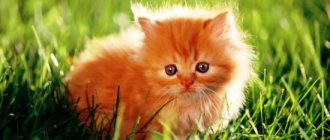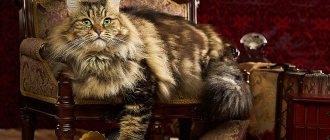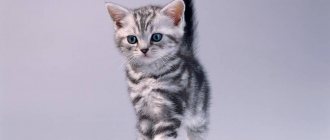Scottish chinchilla golden ticked kittens
What do golden chinchilla kittens look like and how to choose such a kitten.
Recently, a bright new color has appeared in the Scottish Fold breed - this is the golden ticked color. Very often this color is mistakenly called “golden chinchilla”
The golden ticked color came to our breed from British cats. Golden ticked kittens have a special charm. They look like ginger kittens, but unlike ginger kittens, they have bright green emerald eyes and a black tail tip. These kittens also have black heels and black elbows.
If you carefully examine the individual hairs of such a kitten’s fur, you will see an alternation of wide apricot stripes and thin black stripes on each individual hair.
At the same time, in general, a golden ticked kitten looks painted in one apricot color.
Only such a kitten will always have a beautiful pattern in the shape of the letter M on its forehead.
In the pedigree this color is numbered as NY 25
The golden chinchilla is the rarest of the golden colors. In such animals, the amount of black on the hair is so small that it is practically unnoticeable. On each individual hair of such a cat there will be no more than 1/12 black at the very tip of the hair. Usually black can only be seen with a magnifying glass. In the pedigree, this color is numbered as NY 12. Such kittens are born very rarely and the cost of such a kitten is usually several times higher than the cost of a golden ticked one.
Therefore, golden ticked kittens are often sold as golden chinchillas. It sounds very nice, but unfortunately, it is not entirely fair to the buyer.
However, there is another common color that is also passed off as a golden chinchilla - golden shaded.
Such an animal has a residual pattern on the body, because 1/6 of the hair is dyed black, and not 1/12, like the golden chinchilla. But in general, such a kitten will be a bright apricot color, lighter than golden ticked, but slightly darker than golden chinchilla. In the pedigree this color is numbered as NY 11.
In the nurseries of our association, kittens of all three colors described above are born.
Source
BRITISH GOLDEN TABBY: COLOR STANDARD
The British golden tabby color, regardless of the pattern on the coat, must have the following elements in the color (the exception is the ticked color - it has no pattern):
- the letter "M" on the forehead;
- “necklaces” on the chest;
- stripes on the paws;
- tail rings;
- one or two rows of spots on the belly;
- a contrasting pattern on the back is required;
- a light spot on each ear on the outside;
- eyeliner and nose to match the main color.
Golden British Tabby colors are based on a bright, muted yellow shade - just like real gold. Spots or specks of gray color are rejected.
The eye color of a British golden tabby cat can only be green. Eye color takes a long time to develop and “blooms” completely only by 2-3 years.
The beauty of British cats in this color carries both an external aristocracy and a slightly wild, predatory appearance.
Appearance
Each cat breed has characteristics specific to that species. In the case of chinchillas, experts still cannot determine the standard criteria to give accurate definitions of weight, height and other characteristics.
From a distance, the animal's fur appears to be a uniform golden tone, but this is deceiving. Each hair has a double color, at the root it is pure red, the tips are black. The color smoothly transitions into one another, which gives a slight shadedness, which is especially pronounced on the sides and on the back.
You can determine the golden color of a fur coat by the following parameters:
- the basal part of the guard hair and the undercoat are peach-colored;
- the middle part of the guard hair is black;
- upper part – shaded color;
- the tip of the hair is tipped;
- the tip of the tail is the base color.
The Scottish Golden Chinchilla has a medium-length, bouncy, plush-like coat.
Need to know. If the third part of the hair is black, the color is considered shaded, the eighth part is black - chinchilla.
Signs of a Scottish Golden Chinchilla:
- the head is round, small, with a protruding skull, pronounced chin, thick cheeks;
- forehead - with a small flat depression;
- ears – folded, tilted down and forward (Scottish fold) or straight, medium in size (Scottish Straight);
- nose – short, upturned, pale pink, with a dark outline;
- eyes – large, expressive, widely set, emerald in color, with dark edging;
- body – compact, with developed muscles, straight back, chest – raised;
- paws - the same size, rounded, with dark pads and hair between the toes;
- the tail is straight, short, thick, drooping, with a rounded tip.
Scottish cat color charts
When purchasing a Scottish kitten with a passport from a breeder, most likely you will see markings of numbers and letters there. This is an international code used in the classification accepted among breeders. The Scottish breed includes four cats: fold-eared (Scottish Fold), straight-eared (Scottish Straight), long-haired fold-eared (Highland Fold), straight-eared long-haired (Highland Straight).
This is what the color code looks like: XXX.xx.NN.NN.NN.(NN) , where:
XXX . Abbreviated name of the breed in three capital letters: SFS - Scottish Fold, SFS 71* - Scottish Straight, SFL - Highland Fold, SFL 71* - Highland Straight.
xx . Lowercase letters indicating the main coat color (up to two):
| Russian name | ||
| a | blue | blue |
| b | chocolate, brown, chestnut | chocolate, brown, Havana, champagne |
| c | lilac, lavender | lilac, lavender, platinum |
| d | red, flame | red |
| e | cream | cream |
| f | tortoiseshell, patch | tortoiseshell |
| g | blue-cream, blue-tortie | blue cream, blue tortoiseshell |
| h | chocolate-tortie | chocolate tortoiseshell |
| j | lilac-tortie | lilac tortoiseshell |
| n | black, ebony, seal, sable, ruddy | black, ebony, seal, sable, wild |
| o | sorrel, cinnamon, honey | sorrel, cinnamon, honey |
| p | beige fawn | yellow-brown, beige |
| q | sorrel tortie | red-brown tortoiseshell |
| r | beige fawn cake | beige tortoiseshell |
| s | silver, smoke | silver, smoky |
| w | white | white |
| y | golden | golden |
| z | unregistered | unregistered |
NN.NN.NN.(NN) - values of pairs of digits (up to 3 main and 1 auxiliary):
- Numbers from 1 to 35, which decipher the color features (harlequin, van, smoke, etc.):
| Letter (designation) | English name | Russian name |
| 01 | van | van |
| 02 | harlequin | harlequin |
| 03 | bicolour | two-color, bicolor |
| 04 | mitted/white point | with white markings (for color points) |
| 09 | little white spots | white spotting (1-2 cm) |
| 11 | shaded | shaded (1/4 of the top part of the hair is darkened) |
| 12 | tipped, shell | veiled (1/8 of the top part of the hair is darkened) |
| 21 | tabby, agouti | striping, agouti factor |
| 22 | blotched, marble | marble |
| 23 | mackerel, tiger | mackerel, tiger |
| 24 | spotted | spotted |
| 25 | ticked | ticked or Abyssinian |
| 31 | burmese | Burmese |
| 32 | tonkinese | Tonkinese |
| 33 | himalayan or siam | Himalayan, Siamese, point |
| 34 | Singapore | Singaporean |
| 35 | abyssinian | Abyssinian |
- A pair of numbers from 51 to 54 indicating the length of the tail:
| Letter (designation) | English name | Russian name |
| 51 | rumpy | taillessness |
| 52 | rumpy riser | remainder of the tail – 1-2 vertebrae |
| 53 | stumpy | bob – 7-13 cm. curled tail |
| 54 | longy | long/normal tail |
- A pair of numbers from 61 to 67 indicating eye color:
| Letter (designation) | English name | Russian name |
| 61 | blue | blue |
| 62 | yellow, golden | yellow, orange, golden |
| 63 | oddeyed | disagreement |
| 64 | green | green |
| 65 | burmese | Burmese cat eye color |
| 66 | onkinese | Tonkinese cat eye color |
| 67 | himalayan or siam | eye color of Himalayan and Siamese cats |
- A pair of numbers 71 (straight) or 73 (dropping), indicating the shape of the ears.
Cat Golden Chinchilla: 25 photos, description, price
Albion cats have long been popular among fanciers and breeders, thanks to their refined manners and wonderful, kind disposition. The well-known breed in a new color modification has become widespread under the name “chinchilla”, because of the color, which resembles the color of the coat of these funny animals. Nevertheless, it is recognized that, despite many positive features, this variety has not yet become widespread due to many factors.
Since the modern Scottish Golden Chinchilla cat has Persians and exotics among its ancestors, this breed is both long-haired and short-haired.
BRITISH SHORTHAIR GOLDEN TABBY CAT: VARIETIES OF COLOR PATTERNS
British shorthair cat, golden tabby color, is divided into several subspecies:
Ticked color | Marble color |
Spotted color | Striped color |
Tabby colors:
- British ticked (similar to a chinchilla, only darker on the back);
- British spotted (leopard);
- British tabby;
- British marble.
History of the breed
British cats have a very long history, so these animals have excellent health characteristics and a pleasant temperament. Most of them were born in England. Nevertheless, selective breedings were often carried out in other European countries and even in America.
The British and Scots, as a felinological breed, were fully established at the end of the century before last. At the same time, the standard was approved only in the 80s of the 20th century.
British Golden Chinchillas received their unique coloring due to the fact that breeders crossed the Persian chinchilla breeds with another classic variety that has a solid color, or with the British, which have a smoky coat.
Breeders were not satisfied with the color scheme of the irises of the offspring, which often changed from emerald-turquoise to yellowish-green.
In order to preserve their color, they tried to cross Britons with tabbies (tabby cats) with emerald eyes, but this often had a negative effect on the resulting color. For this reason, the selection of animals continued from the first generation with each other with a regular infusion of Persian blood.
The British Golden Chinchilla was bred according to the same principles as silver cats. The only difference is that it was based on an already bred silver chinchilla. Since the gene responsible for the golden coat color was obtained even from Persian ancestors, breeders simply had to preserve it.
Also read a separate article about British chinchillas, where it is written about their silver representatives.
Mr. Cat recommends: description, characteristics, breed standard
Today, these beautiful animals Chinchilla britich gold are very popular and breeders often hear about the desire of buyers to purchase a “Scottish Golden Chinchilla kitten,” but this phrase is wrong.
These cats are indeed of the Scottish or British breed, and they can be either fold-eared or straight-eared, but the phrase Golden Chinchilla refers only to the color, which pets of some other varieties, for example, Persians, can also have. British cats received this color from their Persian ancestors more than half a century ago.
When considering the genetics of a rare color, it will be necessary to analyze several hypotheses of its appearance, since scientists do not have an exact answer, just as there is no genetic test to establish the color unambiguously.
For this, there is only a visual method that combines several features:
- The undercoat part of the coat has an apricot tint due to the fact that the basal parts of the guard hairs are colored in this tone.
- The upper parts of the guard hairs are black, half for tabby colors, one third for shaded colors and one eighth for tipped or ticked animals (this is chinchillas).
- The tip of the animal's tail, paw pads, nose, cornea, and lips have a shade of the base color.
TYPES OF SHADED COLOR GOLDEN BRITISH
The shaded color of Golden Britons can be of the following types:
- black gold shaded;
- blue gold shaded;
- lilac gold shaded;
- chocolate golden shaded;
- golden shaded cinnamon;
- golden shaded faun.
Blue golden shaded British cat: photo
BLACK GOLD SHADED BRITISH CAT NY 11
Of all the shaded gold Britons, the ones most commonly seen are black and blue.
The nose of the shaded British Black Golden cat is brick red with a black rim. Eyes with black eyeliner. Paw pads are black.
BLUE GOLD SHADED BRITISH CAT AY 11
The eyes of a blue golden shaded British cat are always with a dark blue rim. Paw pads are blue. The nose mirror is pink with a blue border.
LILE GOLD SHADED BRITISH CAT CY 11
An extremely rare color in which the paw pads and nose of the Lilac Golden Shaded Briton are dark pink with a slight purple tint. Eyes with a clear pink rim.
Chocolate golden shaded British cat: photo
CHOCOLATE GOLDEN SHADED BRITISH CAT BY 11
The rare Chocolate Golden Shaded Briton has brown paw pads, a dark pink nose with a chestnut edge, and the obligatory brown eye color.
CINNAMON GOLDEN SHADED BRITISH CAT OY 11
In my practice, I have not seen this color and have not even heard about it from breeders, but it may well turn out. This Cinnamon Golden Shaded Briton should have a cinnamon rim to the eyes and the same rim to the pink nose. The paw pads are also cinnamon color.
FAUN GOLDEN SHADED BRITISH CAT PY 11
Blue golden shaded British kitten: photo
Also a color that is theoretically possible, but I have not yet seen. The Golden Shaded British Faun has light pink eye rims and a sand colored nose with a light pink border. The paw pads are beige-pink.
Features of temperament
The character of these animals can be said to be truly English. They are calm, behave with dignity, and have good manners. From an early age, they get used to the litter box without any problems, do not wake up their owners, and wait for people to wake up. These cats build excellent relationships with everyone who lives with them under the same roof.
Children do not irritate Golden Chinchillas much, even if they sometimes bother them with too intrusive communication, in this case the animal simply goes to another place, and there is no question of any bites or scratches.
The basis of the temperament of these animals is clearly expressed in signs of independence. The cat does not tolerate attacks on its freedom, desire for privacy and dignity. One of their characteristic traits can also be called stubbornness.
Care and maintenance
These pets need periodic physical activity. They enjoy playing various outdoor games with their owner.
We should not forget about installing a scratching post for your pet and timely accustoming it to it from an early age. We also recommend reading the article on how to make a scratching post with your own hands.
The Golden Chinchilla needs to be combed at least once a week (read how to properly comb a cat). Animals with long hair will need to be brushed more often.
It also doesn’t hurt to use a specialized shampoo for these cats, which improves the color and condition of the coat. Do not wash your cat with regular human shampoo. Read more about this in a separate article on our website.
It is worth periodically inspecting your ears and, if necessary, cleaning them of accumulated dirt and wax. To maintain dental health, you need to give your cat solid food from time to time. In addition, you can read on our portal Mister Cat how to properly brush your cat’s teeth at home.
Character
The golden tartan's favorite pastime is to be close to its family, actively participate in the owner's life, or just be nearby. Prefers any activity related to a person, but it does not get boring, requiring attention and affection.
She does not tolerate loneliness well; if she is left alone at home, she will get bored and seek companionship. The devotion of the golden Scottish cat is so great that after separation she will not take revenge on her owner, but will gratefully curl up at his feet.
The character of the Golden Scotsman is flexible, loving, compliant. A kind cat gets along well in a family, charms everyone, becoming everyone's favorite. He is friendly towards all family members, but he chooses one owner as his favorite, preferring to spend more time with him.
The Golden Scottish Chinchilla has an innate aristocracy. The animal will never scratch the furniture, climb the curtain, or go to the toilet past the tray. Behavior is mannered, gait is smooth, imposing, with a sense of self-esteem.
He is afraid of heights, so fragile things can be safely put on a shelf.
The Scottish chinchilla has intelligence, the ability to learn, and developed intuition. She observes what is happening, draws conclusions, and treats strangers selectively.
For children who do not offend her, she will be a friend. She retains her playful character until old age, is sociable, friendly, and not vindictive.
Cats of this breed are extremely active and curious. They love active games, happily chasing a ball or imitating “catching up” with a toy. Therefore, your pet needs to buy bright toys, balls, and artificial mice.
Need to know. The Golden Scottish Chinchilla prefers to live without the proximity of other living creatures. If birds, fish or small rodents live in the house, she may hunt them.
Diet
Like most other breeds of domestic cats, the Golden Chinchilla can eat food both in its natural form and ready-made factory-produced food.
If the owner chooses a natural type of feeding for his pet, the cat's diet should include: fish, meat, dairy products, butter, cereals and vegetables.
Meat ingredients of the menu: chicken, rabbit, turkey should be given raw, cut into small pieces and pre-treated in boiling water. Fish should not be present in the diet too often, once or twice a week. It would be better if it were sea.
As for dairy products, they should also not be abused. Once or twice a week should be enough. Fermented milk is healthier for cats; it is better to give kefir rather than milk. Read whether cats can drink milk in a separate article.
When choosing ready-made food, it is necessary to take into account the physiological characteristics of the animal, namely factors such as weight, age, health, tendency to overeat, pregnancy. You need to feed your pet two to three times a day. Also, do not forget to add vitamins and minerals to the diet (with natural feeding, good quality ready-made food already contains all the necessary vitamins).
Features of care
Despite its “royal coat,” the animal is not adapted to low temperatures. A comfortable temperature for him is above 20 degrees Celsius.
Hygiene
Caring for a golden Scottish chinchilla involves several procedures, but the main thing is coat care:
- once a week comb out with a special brush in two directions;
- after combing, collect hairs with a damp hand;
- during the molting period, comb out daily.
Cats do not like bathing, but once every six months they need to do water treatments with a special shampoo.
Process as needed:
- ears - clean out accumulated dirt with a swab moistened with petroleum jelly;
- eyes - wipe with tea leaves, chamomile infusion;
- nose - remove discharge with a napkin;
- teeth - brushed daily with a special soft-bristle brush or a cat brush placed on your finger;
- claws - as they grow, remove them with a nail clipper.
Periodically take the chinchilla for a walk, before putting on a flea collar.
The cat is exceptionally clean and loves hygiene, so the litter box must be kept clean.
Nutrition
Golden Scottish chinchillas have a good appetite and gain weight easily, so the cat’s diet needs to be adjusted.
It is better to feed the animal with premium balanced dry food. It contains the entire complex of vitamins and microelements necessary for the body.
When feeding with natural products, the diet includes:
- boiled chicken, turkey, veal, rabbit, offal;
- boiled sea fish fillet;
- fermented milk products, eggs;
- vegetables, boiled cereals;
- sprouted grains;
- complex of vitamins.
Regardless of what diet you choose, make sure that the kitten drinks a lot of clean water.
Health
Today, several very real versions of the origins of the British with the Golden Chinchilla color have the right to exist. Some of them report that this coloring was first recreated by British felinologist-breeders, while others indicate that American breeders and scientists participated in the development of the color isomorph.
From all these various theories about the origin of the unique color of the traditional English breed, the conclusion remains that the long-term and painstaking work of breeders has made it possible to obtain a truly luxurious shade of wool, which evokes the constant admiration of people.
What is important is that as a result of many, sometimes inbreeding, crossings, Scottish and British Golden Chinchillas have maintained excellent health and immune systems, without losing their gentle temperament.
Purchasing a kitten
The cost of each unique golden kitten in the nursery depends on many characteristics: gender, type of ears (fold or straight), color, purpose of purchase (show, pet or breeding), health status, availability of genetic tests of parents, title and fame of ancestors, pedigree .
Golden British and Scottish Chinchillas with breeding rights and purchased for participation in exhibitions, that is, breeding and show classes, are very expensive, from two to ten thousand dollars, since high-quality animals of this color are very rare.
Golden Chinchillas, which are purchased as pets, without a pedigree or pet class, are several times cheaper.
Source
SHADED BRITISH GOLDEN KITTENS
Shaded British Golden kittens are very rare, especially if they are of good British type. Now many breeders, in pursuit of novelty in color and exclusivity, are working on breeding such rare colors of animals.
The Shaded British Golden kitten can only be born to golden parents, or to a silver with green (and only green) eyes who have the gold gene in their pedigree. Such golden British kittens are not cheap, but the price is justified, since it is an incomparable feeling of pride for your magnificent animal in such a rare color.

